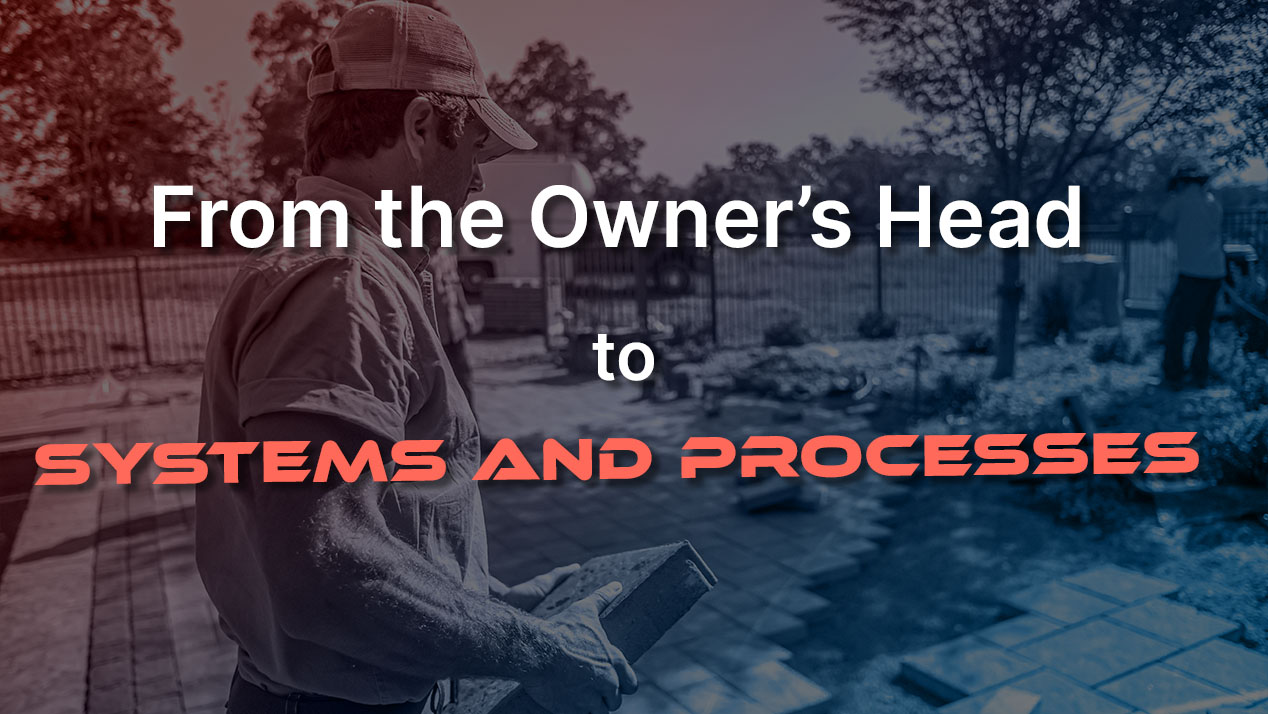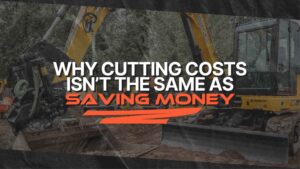From the Owner’s Head to Systems and Processes

Your life as the owner-operator of a landscape business can be hectic without systems and processes. And as you grow, the intensity of the craziness will just continue to increase.
Then, one of two things will happen:
- You hit your ceiling and growth stops. You simply can’t firefight another fire.
- You figure out how to systemize and delegate.
The keys to getting out of the firefighter’s prison in the first point above are in the second point – getting info from the owner’s head and into systems and processes.
Hitting Your Ceiling
I think all of us bump our heads up against the ceiling in some way or another in our journey to grow a business. I usually see landscape owner-operators tap out in the $500k-$2m range. It’s in that range where you simply run out of bandwidth to solve more problems. You can’t take another phone call, you can’t deal with yet another missed order, missed communication, or another callback.
You’re tapped out.
And then, at that moment, you have a choice.
Some of you will choose to just stay right there in the $500k-$2m range long term. You want to continue to be an owner-operator, and would rather focus on being profitable and building a quality life in that revenue range. You personally want to deal with every customer, create every proposal, and be on every job.
And there’s absolutely nothing wrong with that. It all comes down to what you want. If you are passionate about your “boots in the dirt” craft, as opposed to being intent on building a business that can run without you, then this can be an excellent place to settle in for the long haul.
If you do choose this route, you’ll want to focus on
- getting the leads you WANT so you can do the jobs you LIKE
- Say “no” to opportunities that don’t fit the type of jobs you like to do
- Focus on “knowing your numbers” so you can be super profitable, without doing more crews/more production
- Look for ways to save time and streamline things. Being you are the one doing all of it, you want to be as efficient as possible and save time. Work smarter not harder.
Stay Where You Are – No Systems Needed
In this model, it’s all about getting to do the work you love and continuing to do more of it. And having enough leads for the work you love, you have no issue with saying no to the work you DON’T love. Remember, it’s all about the quality of life.
You aren’t looking to grow a ton, not looking to add crews or do more production. Just looking to make more money without adding the complexity of additional crews, service lines, etc.
In this model, you’ll often eke out more production by being an equipment and tool junkie. Cranking out more production with the same amount of guys, by being more efficient and effective with the right equipment.
You also wanna make your life simpler. Save time in dealing with leads, get faster at estimating, having the ability to track jobs without a lot of paperwork. And knowing your numbers to ensure you are meeting your profit/income goals. Your path to achieving your personal income goals is not via adding more crews, it’s in knowing your numbers and making sure you’re making that money on every job you do.
There are always pros and cons though. In this model, if you break a leg, the business stops. You just have to have a contingency plan in place.
A contingency plan could look like having an excellent number 2 team member, that could step into your shoes in a pinch. This is where we get back to the title of the article though – for this to be possible, you need to do an excellent job of documenting your processes, and getting things out of your head and into a system and process. You can’t rely on the fact that “I’ll always be here”.
Pretend you’ll never do this task again, what would the person coming behind you need to know to be able to do the task just as well as you do?
For instance: estimating. Instead of just pulling a number out of your years of experience, get your knowledge and experience into templates and production rates. It’ll not only save you time today but will make it loads easier for anyone else to produce an estimate just like you do.
Systemizing and Delegating
This mode is different, but a lot of the same principles I mentioned above apply, albeit maybe just for different reasons.
This model is usually employed if you started out as an owner-operator, you run into your ceiling, and you want to continue growing.
So you add crews, production, and maybe additional service lines. But now, instead of getting info out of your head and into a system and process being a contingency plan, it is now THE next required step to move forward and grow.
You’ve gotta remove yourself as the bottleneck. You can no longer allow yourself to be the only person in the company that can estimate a job. Or deal with a callback. Or handle a complaint. Or run payroll. Or do invoicing.
In practical terms this means getting off of your notes folder in your phone, quitting eyeballing a job and coming up with a number, no longer running your schedule in your head, you get the idea.
You’ve gotta do the work of taking what you know, and systemizing it.
There’s only one problem.
It is stinking hard.
How to Create Systems and Processes?
Building systems and processes is hard work. There are a lot of false starts, trial, and error, backing up, and trying again. Mistakes will happen.
What do I mean by building systems and processes? Let me describe a practical example:
Let’s say you sold a job, and you know from your schedule (in your head) that you’ll start the job roughly a month from now. One of the products in the job is not a stock item, and you know that (in your head), so you place the order right away to allow sufficient time for the products to come in.
Easy peasy.
Now, let’s imagine you hire a salesperson, or promote your lead foreman to start selling some jobs. He sells a job. He doesn’t know when the job can be started (schedule is in your head). So he has to call you. He knows from past experience that the supply yard usually can pull orders together in a day or two. He doesn’t know that one of the products on his estimate is not a stock item. So he places the order a week ahead of job start time thinking he’s got plenty of time. The job starts, but not all materials are in. Now the job is held up.
Big problem, eh?
You could blame the salesperson for not checking
You could tell them they need to memorize all the non-stock items.
Or, this is what I like to do, you could sit back, reflect, and discuss amongst yourselves, “what is the real problem here?” “What is the real source of the issue?” “What can we do next time to make sure this never happens again?”
How about ordering the materials the moment the job is sold, and giving the supply yard a tentative start date. Let them deal with the items that take longer to get in, etc. They know their stock better than you ever will.
Anyway, the point I want you to get is the importance of reflecting and asking:
- What is the real problem here?
- Salesperson didn’t know it’d take so long to get the order in.
- What needs to be true so that this never happens again?
- Place the order immediately after selling the job.
Identify the real source of the problem, then install a system or process to nip the issue in the bud.
Conclusion
I’m sure I don’t have to convince you that building systems and processes are hard. You already know it is. Frankly, it’s easier to continue being the kingpin and bottleneck of the organization. Keep on doing what you’ve always done, even if that way is broken. It’s just that if you settle for this, you’ll never grow your business beyond what your firefighting capacity is.
There’s one more thing I have to address.
In this whole discussion of building systems and processes, yes, software that fits your business well is a massive shortcut. It’s like pulling proven systems and processes out of the box and deploying them across your business.
As the founder of SynkedUP, I see only one problem that continues to rear its ugly head. Owner-operators get excited about upgrading their operation, whip out their credit card, and sign up for a software, thinking this is the silver bullet that’s going to fix all their issues.
And it can.
But you have. to. use. it.
Whipping out your credit card and signing up is the easy part.
Actually exercising discipline and learning, teaching your team, implementing, adapting, deploying, and tweaking things, is the hard part. You’ve gotta get buy-in from the team. You ARE going to be tempted to fall back into your old ways. If you don’t LEAD, you will get pushback from your team.
Software is amazing, but the buttons aren’t magic. You still have to show up as a leader in your business and team.
There are no silver bullets.
You still have to put in the work.
The way software works is garbage in, garbage out.
If you lead well, adapt your business to the software of your choice, define your process, and then discipline yourselves to FOLLOW the process, you don’t have the garbage in, garbage out problem.
Rather you have the beautiful experience of actually getting out of it, what you put into it.
Funny how life works that way, huh? 😜

Weston Zimmerman
CEO and co-founder
See SynkedUP in action
Related Articles
What is the Most Difficult Challenge You’ve Overcome?
Cutting costs isn't the same as saving money. Learn how to use leverage, not panic, to drive real profit and...
Why Time Tracking is Critical for Contractors
Cutting costs isn't the same as saving money. Learn how to use leverage, not panic, to drive real profit and...
Why Cutting Costs Isn’t the Same as Saving Money
Cutting costs isn't the same as saving money. Learn how to use leverage, not panic, to drive real profit and...
Slow Down to Speed Up
A quick leadership gut check: Are you building what really matters? Slow down, realign, and lead with intention.
The One Calculation Every Contractor Should Know
Contractors: If you’re not factoring in overhead, you're not pricing right. Learn how to calculate breakeven and stop guessing your...
What Owns Your Day? Urgency or Importance?
Stuck in a cycle of chaos and urgent tasks? Break the cycle with better systems, clear processes, and leadership that...
Taking Care of Your Team
Leadership isn't barking orders - it's listening, appreciating, and building problem solvers. Here's how to lead without burning out.
The Cost of Avoiding Issues in Your Business
Avoiding stuff in business adds up, with interest. Don't try harder, build systems that make success default. Do hard things,...
Leveraging Your Job Data for More Accurate Estimates
Stop estimating from the gut. Track time, collect job data, and turn it into faster, more accurate production rates.
How the Best Contractors Ensure Profitability
Running over estimated hours is one of the biggest silent profit killers in contracting. Here's how to track it, catch...









